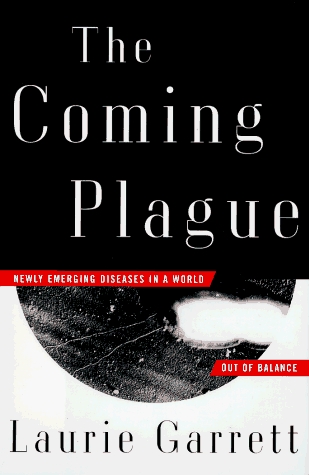The Coming Plague
First published in 1994 in hardcover by Farrar, Straus and Giroux, THE COMING PLAGUE: Newly Emerging Diseases in a World Out of Balance was a New York Times bestseller in 1994-5. Laurie Garrett researched and wrote THE COMING PLAGUE for ten years, starting in the mid-1980s when the very premise of the effort was highly controversial.
When Laurie Garrett started working as a journalist her training in immunology had been grounded in the widespread belief that infectious diseases had been conquered. By the early 1980s biomedical scientists throughout the wealthy world focused on cancer and heart disease, feeling that the antibiotic and vaccine era ushered the demise of infectious threats. But Garrett kept hearing about strange outbreaks of deadly, mysterious diseases such as Ebola, which seemingly contradicted the mainstream view. As early as 1976, with the advent of Legionnaires Disease, Garrett started collecting news and scientific papers regarding odd outbreaks and strange epidemics.
By the late 1980s, with the world shaken by the strangest and deadliest arrival of all – HIV and AIDS – Garrett traveled widely in search of understanding: Why did new viruses and bacteria appear, seemingly out of nowhere? Why couldn’t modern medicine vanquish HIV and other newly emerging microbes? How were scientists battling these diseases? Had hubris put the arrogant biomedical world of the late 20th Century at peril?
As the 1980s came to a close the National Academy of Sciences convened a landmark gathering focused on newly emerging viruses. For days experts shared insights in Washington, growing collectively anxious. By the close of the gathering Garrett recognized that her anxieties about the infectious diseases threat were shared by such extraordinary Nobel Prize-winning scientists as Joshua Lederberg, Howard Temin, and David Baltimore.
During the 1992-3 academic year Garrett was a Fellow at the Harvard School of Public Health, where she worked closely with Drs. Mary Wilson, Uwe Brinkman, Andrew Spielman, and their Harvard colleagues to understand the origins of seemingly “new” viruses, and the amplification systems that fostered their worldwide spread in the age of globalization. The bulk of THE COMING PLAGUE was written at Harvard.
During the administration of President Bill Clinton epidemic threats were elevated to official elements of U.S. national security. An expert in the field was, for the first time in U.S. history, appointed to the National Security Council.
Former UN Ambassador Richard Holbrooke successfully pushed the Security Council in 2000 to convene its first session on the HIV/AIDS pandemic. The following year, on the 20th anniversary of recognition of the new disease, a United Nations General Assembly Special Session was held, entirely focused on the AIDS pandemic.
In 2005 Garrett spearheaded an analysis of the links between national security and HIV, issued jointly with the UN AIDS Programme to the Security Council. The report came two years after the SARS epidemic shook up China and a dozen other nations, prompting widespread elevation of concern about the dangers of newly emerging disease, as well as bacteria and viruses that were evolving drug-resistant forms. In the years since nations the world over have officially designated HIV, drug resistant tuberculosis, virulent influenza, and other pandemic diseases as national security concerns.
What seemed an acutely controversial premise in 1994 is mainstream thought in the second decade of the 21st Century.
QUICK LINKS





